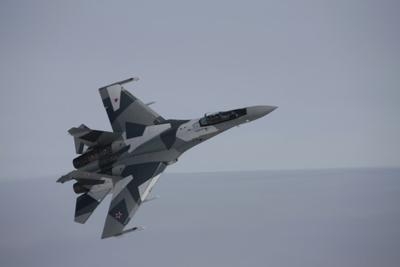Thu, Jan 19, 2012
Airplane Reportedly Performed 'Flawlessly'
The 3rd serial multi-purpose fighter — Su-35S-3 joining
the flight test program Tuesday. Piloted by test pilot Taras
Artsebarsky, the airplane took off from the airfield at the
Komsomolsk-on-Amur Aircraft Production Association. Various modes
of propulsion and integrated control systems, as well as stability
and controllability characteristics, were tested in the flight,
which lasted over two hours. Engines, systems and equipment all
reportedly operated 'flawlessly'.

The Su-35 fighters have already flown more than 400 flights on
the flight tests program. The first and second Su-35s were
delivered to the 929th State Flight Test Center (GLITS) for the
State Joint Tests (SJT), and on August 15 last year they started to
implement the agreed program. At the same time the first serial
production fighter — Su-35S-1 has also joined the
program.
The first and second Su-35s carried out preliminary flight
tests. The basic set of flight and technical specifications of the
on-board equipment and the characteristics of super
maneuverability, stability and control characteristics, the
characteristics of the power plant, the work of the navigation
system were fully confirmed during the tests. The maximum
ground-level speed is 755 knots, with the speed at altitude nearly
1,300 knots. The airplane has a service ceiling of 59,000 feet. The
detection range of targets in the “air-to-air” mode is
over 250 miles, significantly higher than that of the combat
aircraft currently in service. The onboard OLS (optical locator
station) can detect and track multiple targets at ranges exceeding
50 miles. The system is ready to undergo testing for operational
use.
The special features of the aircraft include a new avionics suite
based on digital information control system integrating onboard
systems, a new phased antenna array radar with a long aerial target
detection range and with an increased number of simultaneously
tracked and engaged targets (30 aerial targets tracked and 8
targets engaged plus the tracking of 4 and engagement of 2 ground
targets), and new enhanced vectored thrust engines. The Su-35 has a
diverse suite of long-, medium- and short-range weapons. It can
carry guided aerial munitions for anti-radar and anti-ship actions
as well as general purpose munitions, guided and unguided aerial
bombs. The radar signature of the fighter has been reduced by
several times as compared to that of the fourth-generation aircraft
by coating the cockpit with electro-conducting compounds, applying
radio absorption coats and reducing the number of protruding
sensors. The service life of the aircraft is 6,000 hours flight
hours; the life cycle is 30 years of operation. The assigned
service life of vectored thrust engines is 4,000 hours. (Image
provided by Sukhoi)
More News
Aero Linx: International Federation of Airworthiness (IFA) We aim to be the most internationally respected independent authority on the subject of Airworthiness. IFA uniquely combi>[...]
Ultrahigh Frequency (UHF) The frequency band between 300 and 3,000 MHz. The bank of radio frequencies used for military air/ground voice communications. In some instances this may >[...]
A Few Questions AND Answers To Help You Get MORE Out of ANN! 1) I forgot my password. How do I find it? 1) Easy... click here and give us your e-mail address--we'll send it to you >[...]
From 2019 (YouTube Edition): Learning To Paint Without Getting Any On Your Hands PPG's Aerospace Coatings Academy is a tool designed to teach everything one needs to know about all>[...]
Also: Sustainable Aircraft Test Put Aside, More Falcon 9 Ops, Wyoming ANG Rescue, Oreo Cookie Into Orbit Joby Aviation has reason to celebrate, recently completing its first full t>[...]
 ANN's Daily Aero-Linx (05.06.25)
ANN's Daily Aero-Linx (05.06.25) ANN's Daily Aero-Term (05.06.25): Ultrahigh Frequency (UHF)
ANN's Daily Aero-Term (05.06.25): Ultrahigh Frequency (UHF) ANN FAQ: Q&A 101
ANN FAQ: Q&A 101 Classic Aero-TV: Virtual Reality Painting--PPG Leverages Technology for Training
Classic Aero-TV: Virtual Reality Painting--PPG Leverages Technology for Training Airborne 05.02.25: Joby Crewed Milestone, Diamond Club, Canadian Pilot Insurance
Airborne 05.02.25: Joby Crewed Milestone, Diamond Club, Canadian Pilot Insurance



